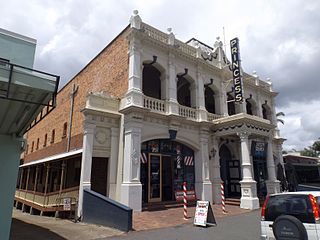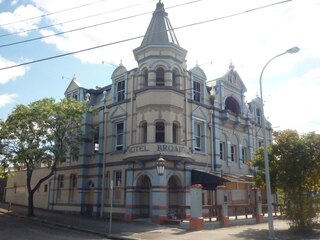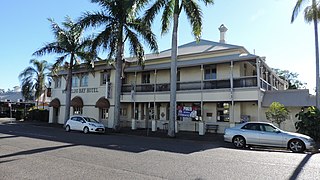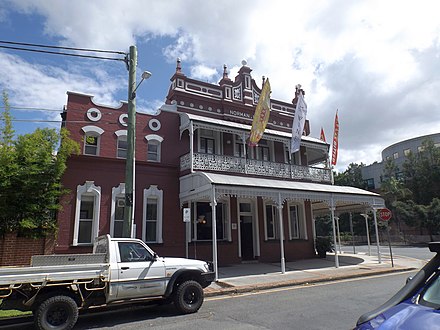
Woolloongabba is a suburb of Brisbane, Australia. It is located 2 kilometres (1.2 mi) south-east of the CBD, and contains the Brisbane Cricket Ground and the Princess Alexandra Hospital. It is crossed by several major roads including the Pacific Motorway. The suburb was once home to a large tram depot.

Ipswich Road is one Brisbane's main roads connecting Brisbane to the nearby city of Ipswich, via the Ipswich Motorway. Ipswich Road used to be part of the Cunningham Highway. Logan Road, Pacific Motorway, and Beaudesert Road are the other major roads in the south of Brisbane. The road was an important transport route in 19th century Brisbane.

Breakfast Creek Hotel is a heritage-listed hotel at 2 Kingsford Smith Drive, Albion, City of Brisbane, Queensland, Australia. It was designed by Simkin & Ibler and built in 1889 to 1890 by Thomas Woollam & William Norman. It was added to the Queensland Heritage Register on 21 October 1992.

The Orient Hotel is a heritage-listed hotel at 560 Queen Street, Brisbane CBD, City of Brisbane, Queensland, Australia, on the corner of Ann Street. It was originally built as the Excelsior Hotel in 1875 and extended in 1884, both of which were designed by Brisbane architect Richard Gailey. It was added to the Queensland Heritage Register on 23 April 1999.

Jubilee Hotel is a heritage-listed hotel at 464-468 St Pauls Terrace, Fortitude Valley, City of Brisbane, Queensland, Australia. It was designed by Richard Gailey and built from 1887 to 1888. It was added to the Queensland Heritage Register on 21 October 1992.

Princess Theatre is a heritage-listed theatre at 8 Annerley Road, Woolloongabba, Queensland, Australia. It was designed by architect John Beauchamp Nicholson and built in 1888. It is also known as South Brisbane Public Hall and Boggo Road Theatre. It was added to the Queensland Heritage Register on 21 October 1992.

Woolloongaba Post Office is a heritage-listed former post office at 765 Stanley Street, Woolloongabba, City of Brisbane, Queensland, Australia. It was designed by Thomas Pye and built in 1905 by Thomas Rees. It is also known as Woolloongabba Post & Telegraph Office. It was added to the Queensland Heritage Register on 24 January 2003.

Broadway Hotel is a heritage-listed hotel at 93 Logan Road, Woolloongabba, City of Brisbane, Queensland, Australia. It was designed by John Hall & Son and built from 1889 to c. 1942 by Wooley & Whyte. It was added to the Queensland Heritage Register on 21 October 1992. The building has been in a state of significant disrepair and neglect for several years, covered in graffiti and broken panelling, and in September 2018 was destroyed by a fire.

Woolloongabba Police Station is a heritage-listed former police station at 842–848 Main Street, Woolloongabba, City of Brisbane, Queensland, Australia. It was designed by the Queensland Department of Public Works and built from 1913 to 1936. It is also known as South Coast District Headquarters and Woolloongabba Police Station. It was added to the Queensland Heritage Register on 25 November 1994.
John Beauchamp Nicholson was an architect in Brisbane, Queensland, Australia. A number of his works are heritage-listed.

Taylor–Heaslop Building is a heritage-listed commercial building at 10-14 Logan Road, Woolloongabba, City of Brisbane, Queensland, Australia. It was designed by John Beauchamp Nicholson and built from 1889 to 1890. It is also known as Ernest Reid (draper), John Evan's Cash Draper, George Logan Draper, Johns & Co Draper, People's Cash Store (grocers), JR Blane, and Moreton Rubber Works. It was added to the Queensland Heritage Register on 6 February 2006.

Shop Row is a heritage-listed commercial building at 609 & 613 Stanley Street, Woolloongabba, City of Brisbane, Queensland, Australia. It was built c. 1903. It was added to the Queensland Heritage Register on 21 October 1992.

Clarence Corner is the junction of Stanley Street and Annerley Road in Woolloongabba/South Brisbane in Brisbane, Queensland, Australia. It gives its name to the local area.

Pollock's Shop House is a heritage-listed general store at 617-619 Stanley Street, Woolloongabba, City of Brisbane, Queensland, Australia. It was built c. 1865. It was added to the Queensland Heritage Register on 21 October 1992.

The Phoenix Buildings are heritage-listed commercial buildings at 647 Stanley Street, Woolloongabba, City of Brisbane, Queensland, Australia. They were designed by Richard Gailey and built from 1889 to 1890 by James Rix. They were added to the Queensland Heritage Register on 24 May 1995.

Waterloo Bay Hotel is a heritage-listed hotel at 75 Berrima Street, Wynnum, City of Brisbane, Queensland, Australia. It was built in 1889 by George Gibbs and extended in 1918 to a design by George Henry Male Addison. It was added to the Queensland Heritage Register on 28 July 2000.

Normanby Hotel is a heritage-listed hotel at 1 Musgrave Road, Red Hill, City of Brisbane, Queensland, Australia. It was designed by John B Nicholson and built in by Thomas Game. It was extended in 1917 to a design by George Henry Male Addison. It was added to the Queensland Heritage Register on 21 October 1992.

Royal George Hotel and Ruddle's Building is a heritage-listed hotel at 323-335 Brunswick Street, Fortitude Valley, City of Brisbane, Queensland, Australia. It was built from c. 1850 to the 1960s. It is also known as Bush & Commercial Inn, Commercial Inn, Freemasons Arms, and Ruddle's Corner. It was added to the Queensland Heritage Register on 3 August 1998.

Castlemaine Perkins Building is a heritage-listed former warehouse at 418-420 Adelaide Street, Brisbane City, City of Brisbane, Queensland, Australia. It was designed by Thomas Ramsay Hall and built from 1918 to 1919 by George Albert Baumber and was extended in 1928 to 1929. It is also known as Castlemaine Brewery and Quinlan, Gray & Co Building. It was added to the Queensland Heritage Register on 6 March 2009.

Hotel Metropole is a heritage-listed hotel at 253 Brisbane Street, West Ipswich, City of Ipswich, Queensland, Australia. It was designed by George Brockwell Gill and built in 1906. It was added to the Queensland Heritage Register on 21 October 1992.





















